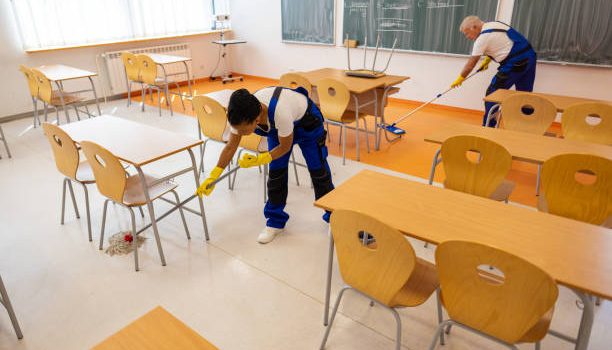
Childcare Cleaning: Best Practices for a Hygienic Learning Environment
Maintaining a clean and hygienic environment in childcare centers is essential for the well-being and development of children. A well-sanitized space not only helps prevent the spread of illnesses but also creates a safe and healthy environment conducive to learning and growth. In this article, we will explore the best practices for effective childcare cleaning, focusing on daily, weekly, and monthly routines. Additionally, we will discuss the importance of using non-toxic, eco-friendly cleaning products and specialized equipment to meet hygiene standards and regulations.
The Importance of a Hygienic Environment
Children are more vulnerable to infections and illnesses due to their developing immune systems. In a childcare setting, where children interact closely with one another, germs can spread rapidly. A hygienic environment plays a crucial role in reducing the risk of illness, ensuring that children remain healthy and can fully participate in learning activities. Furthermore, a clean space supports cognitive and physical development by providing a safe area free from harmful bacteria and allergens. By adhering to strict cleaning protocols, childcare centers can meet hygiene standards and regulations, ensuring the safety and well-being of the children in their care.
Daily Cleaning Practices
Daily cleaning is the foundation of maintaining a hygienic childcare environment. Regular cleaning tasks should be performed throughout the day to ensure that all areas remain clean and safe. Key areas that require daily attention include:
- Surfaces and Toys: High-touch surfaces such as tables, chairs, and door handles should be wiped down regularly with disinfectant. Toys, especially those shared among children, should be cleaned and sanitized daily to prevent the spread of germs.
- Restrooms: Bathrooms must be cleaned multiple times a day, with particular attention to toilets, sinks, and diaper-changing stations. These areas should be disinfected to prevent the spread of bacteria and viruses.
- Floors: Sweeping and mopping floors daily helps remove dirt, dust, and potential allergens. This is especially important in areas where children play and crawl.
- Trash Disposal: Waste bins should be emptied regularly, and the bins themselves should be cleaned and disinfected to prevent odors and the attraction of pests.
Daily cleaning tasks are crucial for maintaining a basic level of hygiene, but they should be complemented by more thorough cleaning practices on a weekly and monthly basis.
Weekly Cleaning Practices
Weekly cleaning involves more intensive tasks that target areas that may not be addressed during daily routines. Deep cleaning is essential to ensure that hidden dirt and germs are effectively removed. Key areas for weekly cleaning include:
- Carpets and Rugs: Vacuuming carpets and rugs daily is important, but they should also be deep cleaned weekly. This helps remove embedded dirt, dust mites, and allergens that can affect air quality and children’s health.
- Windows and Blinds: Clean windows and blinds to remove dust, fingerprints, and smudges. This not only improves the appearance of the space but also enhances natural light, creating a brighter learning environment.
- Kitchen Areas: The kitchen, where children’s meals are prepared, should undergo a thorough cleaning weekly. This includes wiping down appliances, cleaning countertops, and sanitizing food storage areas.
- Toys and Play Equipment: While toys are cleaned daily, they should be thoroughly disinfected weekly, especially those that are difficult to clean or have many crevices where germs can hide.
Monthly Cleaning and Maintenance
Monthly cleaning focuses on areas that require specialized attention and maintenance to ensure the overall safety and hygiene of the childcare environment. Key tasks include:
- Disinfection: In addition to regular cleaning, a monthly deep disinfection of all areas, including classrooms, restrooms, and play areas, is essential to eliminate any lingering germs and bacteria.
- HVAC Systems: The heating, ventilation, and air conditioning (HVAC) systems should be inspected and cleaned monthly to ensure good air quality. Clean filters and ducts help prevent the circulation of dust and allergens, reducing the risk of respiratory issues.
- Air Quality: Monitor and improve air quality by using air purifiers and ensuring proper ventilation. This is particularly important in childcare settings, where children are more susceptible to respiratory problems.
Use of Non-Toxic, Eco-Friendly Cleaning Products
When it comes to childcare cleaning, the safety of the products used is paramount. Non-toxic, eco-friendly cleaning products should be the standard in any childcare setting. These products are free from harsh chemicals and harmful residues, ensuring that children are not exposed to toxins that could affect their health. Additionally, eco-friendly products are better for the environment, supporting sustainability efforts.
Specialized Equipment and Professional Services
Investing in specialized cleaning equipment can enhance the effectiveness of cleaning routines. For example, steam cleaners can sanitize surfaces without the need for harsh chemicals, while high-efficiency particulate air (HEPA) vacuum cleaners can trap allergens and improve air quality.
For comprehensive cleaning, many childcare centers opt for professional daycare cleaning services. At EonClean, we are committed to creating safe and hygienic environments where children can thrive. Let us help you uphold the highest cleanliness standards, ensuring the health and safety of your young learners. Contact EonClean today to learn more about our specialized childcare cleaning services and discover how we can support your center in providing the best possible care